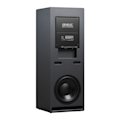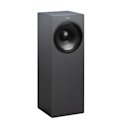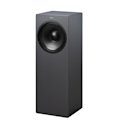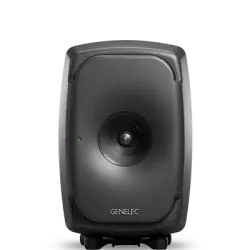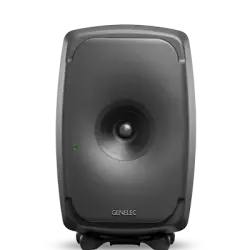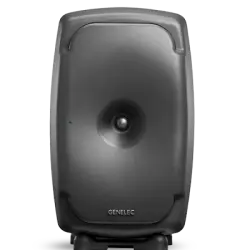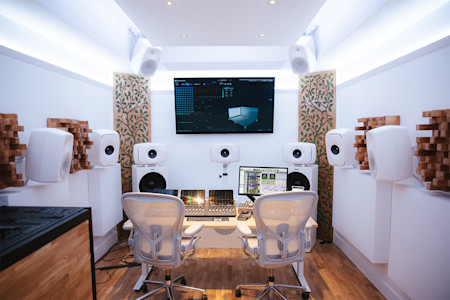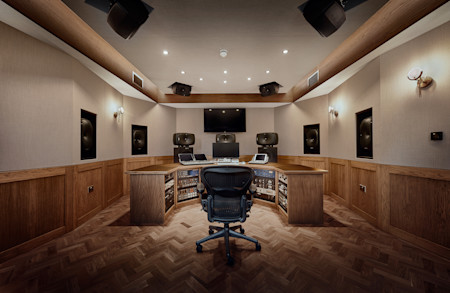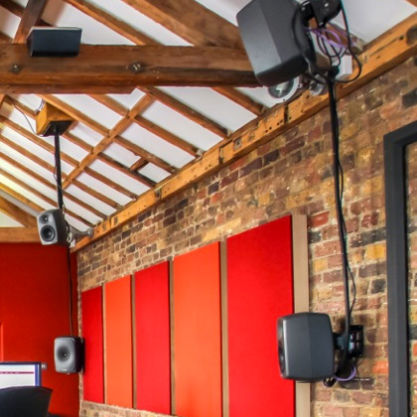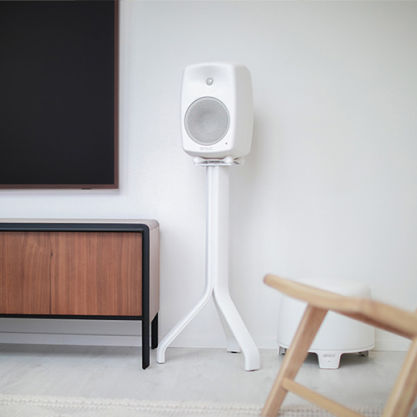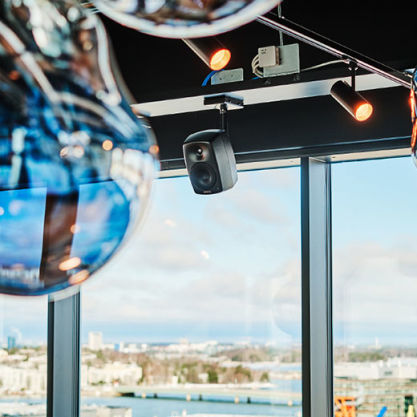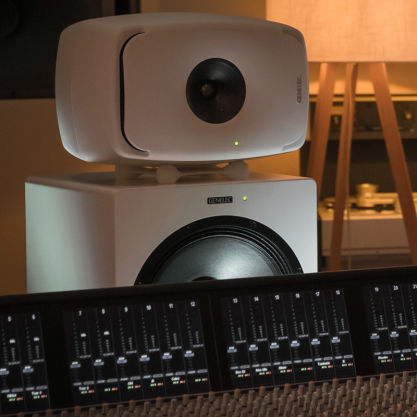An absolute revelation in low frequency performance. With the W371A, you can finally wave goodbye to the detrimental influences of your room on LF reproduction.
W371A
SAM™ Woofer System

Smart Active Monitoring (SAM™) and GLM™ calibration technology

Optimised Amplifiers

SPL
120 dB

Frequency Response
23 Hz - 500 Hz (-6 dB)

Dimensions
H 1108 x W 400 x D 400 mm, (view in inches)

Full-range, yet free-standing
The W371A seamlessly complements our 8341A, 8351B and 8361A models to creates a series of full-range monitoring solutions with unrivalled neutrality and supreme control of directivity and the effects of room acoustics. Experience all the benefits of a main monitor, but with the freedom to locate this free-standing system in optimal positions within your control room; even providing the option to switch between nearfield and main monitors without image-shifting.
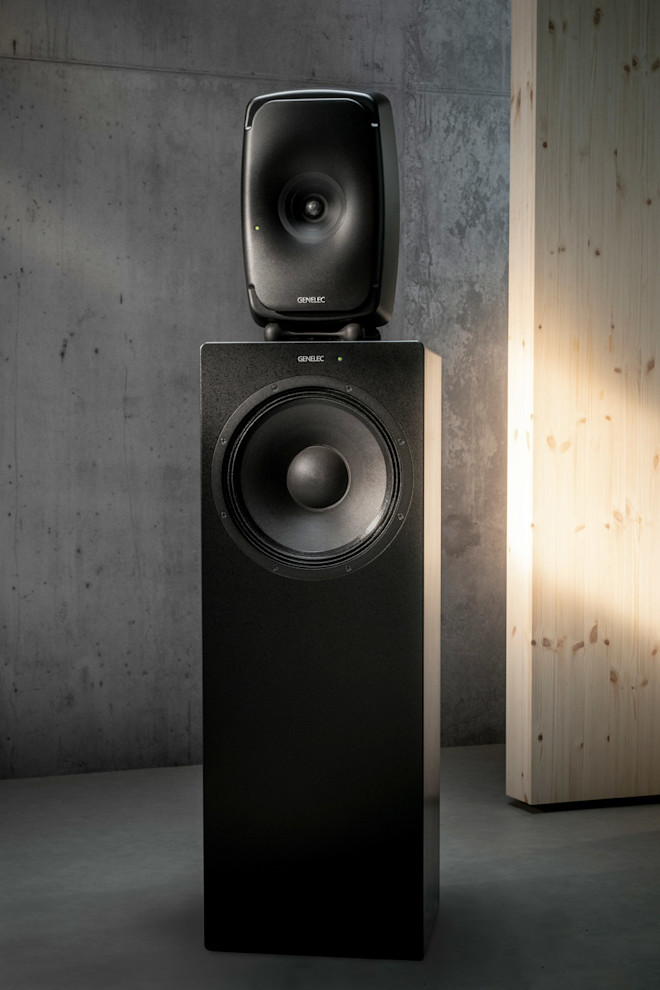
Flat, smooth response
The W371A tailors system performance carefully to the room, offering flatter, smoother in-room response with more coherent LF imaging. Three different operating modes allow a choice of flat and neutral LF response avoiding ‘acoustic notching’, continued directivity of the main monitor down to the lowest LF frequencies, or reduction of detrimental reflections by the walls, ceiling or floor of your room. The W371A then uses GLM software to select and optimise the signal processing for the best LF radiation mode, taking into account both the monitor location and listening position.
W371A
Awards
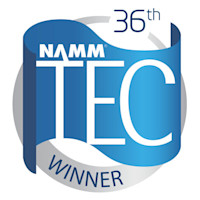
W371A Adaptive Woofer System has won the Studio Monitor category of 2021 NAMM TEC Awards.
Technical Specifications

SPL
120 dB

Amplifier Power
2 X 400 W Bass (Class D)

Frequency Response
23 Hz - 500 Hz ("-6 dB")

Accuracy of Frequency Response
± 3 dB

Driver Dimensions
⌀ 356 mm Bass + ⌀ 305 mm Bass (view in inches)

Dimensions
H 1108 x W 400 x D 400 mm, (view in inches)

Weight
61 kg / 134.5 lb

Connections
1 x XLR Analog Input
1 x XLR Analog Output
1 x XLR AES/EBU Input
1 x XLR AES/EBU Output
2 x RJ45 Control
W371A SAM™ Woofer System
SAM™ Woofer System
Technical Specifications
An absolute revelation in low frequency performance. With the W371A, you can finally wave goodbye to the detrimental influences of your room on LF reproduction.

System Specifications
Frequency Response
(± 3 dB)
Low cutoff -6dB
23 Hz
High cutoff -6dB
500 Hz

SPL
Peak SPL Maximum peak SPL output with pink noise, measured in half space at 1 meter. (Long term output is limited by driver unit protection circuitry)
≥123 dB
Short term max SPL Maximum short term sine wave SPL output averaged 100 Hz to 500 Hz, measured in half space at 1 meter.
≥120 dB
Self-generated noise
Self-generated noise Self generated noise level in free space at 1 m on axis (A-weighted)
≤15 dB SPL
Weight
Weight61 kg (134.5 lb)
Dimensions
Height
1108 mm
Width
400 mm
Depth
400 mm

Enclosure
Enclosure material
MDF
Drivers
Driver type
Cone
Diameter
356 mm
Driver type
Cone
Diameter
305 mm
Directivity


Harmonic distortion
Amplifier Section
Amplifiers
2 x 400 W Class D
Mains voltage
100-240 VAC 50/60Hz
Power consumption
ISS Active
≤2 W
Idle
≤40 W
Full output
600 W
Signal processing section
Connectors
Input Analogue signal input connector XLR female, balanced 10 kOhm
Output
Input Digital signal input connector XLR female 110 Ohm
Output Digital signal output / Thru connector XLR male 110 Ohm
2 x Control
Product Variants
Product codes
For even more technical details please see product operating manual.
Key Technologies

Smart Active Monitoring (SAM™) and GLM™ calibration technology

Optimised Amplifiers

Protection Circuitry

Intelligent Signal Sensing (ISS™) Technology

Active Crossovers

Laminar Integrated Port (LIP™) Technology

Reflex Port Design

Room Response Compensation
Networked Smart Active Monitor (SAM™) Systems feature automatic calibration to the environment.

Now, more than ever, audio productions are engineered in tighter, more confined working environments. This increases acoustic problems and lowers the reliability of monitoring. At the same time, an audio engineer's need to trust a reliable and precise monitoring system that reproduces sound neutrally and without distortion has not changed.
Built upon the solid electro-acoustic foundations of our 1200, 8000 and 7000 Series products, Genelec SAM Systems are today’s most advanced and flexible monitoring solutions. They are an indispensable tool for audio professionals, as they automatically adapt to the acoustic environment and correct for level, delay and room anomalies. SAM Systems are controlled using Genelec's proprietary Loudspeaker Manager (GLM™) network and software, enabling you to build a highly flexible and reliable monitoring system.
GLM is a highly intuitive and powerful monitor control networking system that manages connectivity to all SAM studio monitors and subwoofers on the network. GLM software features adjustment of level, distance delay and flexible room response compensation equalisation with our state-of-the-art, highly robust AutoCal™ 2 algorithm automated calibration system. All parameters and settings are stored in system setup files or saved in each individual monitor or subwoofer, if the GLM network needs to be disconnected.
Also, all acoustical features of SAM Systems can be optimised and tailored for different working styles or client demands. Additionally, even if the monitors or the production projects move between rooms, you can expect SAM technology to provide the highest consistency in monitoring, providing neutral soundstage imaging with low distortion – in each environment.
Genelec SAM Systems offer a comprehensive, solution-oriented, intelligently networked product range supporting analogue and digital signals in virtually any working environment.
Each transducer is driven by its own optimised amplifier.
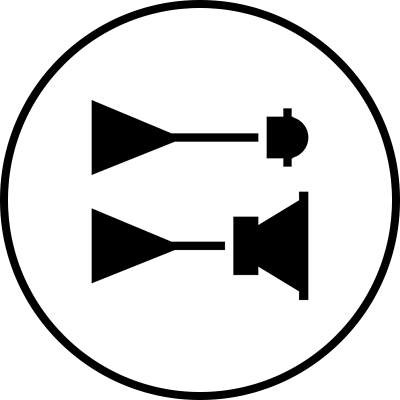
Audio electronic crossovers allow to split the audio signal into separate frequency bands that can be separately routed to individual power amplifiers, which are then connected to specific transducers optimised for a particular frequency band.
In a typical 2-way loudspeaker system, the active crossover needs two power amplifiers — one for the woofer and one for the tweeter. The power amplifiers are connected directly to the drivers of an active loudspeaker, resulting in the power amplifier’s load becoming much simpler and well known. Each driver-specific power amplifier has only a limited frequency range to amplify (the power amplifier is placed after the active crossover) and this adds to the ease of design.
The active design principle offers multiple benefits:
- The power amplifiers are directly connected to the speaker drivers, maximising the control exerted by the power amplifier’s damping on the driver’s voice coil, reducing the consequences of dynamic changes in the driver electrical characteristics. This may improve the transient response of the system.
- There is a reduction in the power amplifier output requirement. With no energy lost in the passive crossover filter components, the amplifier power output requirements are reduced considerably (by up to 1/2 in some cases) without any reduction in the acoustic power output of the loudspeaker system. This can reduce costs and increase audio quality and system reliability.
- No loss between amplifier and driver units results in maximum acoustic efficiency.
- Active technology can achieve superior sound output vs. size vs. low frequency cut-off performance.
- All loudspeakers are delivered as a factory aligned system (amplifiers, crossover electronics and enclosure-driver systems).
Sophisticated drive unit protection circuitry for safe operation.

When working in critical audio production environments it is essential that monitoring systems remain reliable and functional at all times. One of the main reasons behind Genelec’s excellent success in broadcasting environments is the reliability of our products and a key element behind the reliability is the internal protection circuitry found in all products since 1978.
The protection circuitry prevents driver failures by detecting signal levels, and in case of sudden peaks or constantly too high levels, taking the signal level down automatically. Of course this feature does not affect the sound quality in any way when working within the specifications of the loudspeaker, but only prevents inadequate input signals from breaking the loudspeaker.
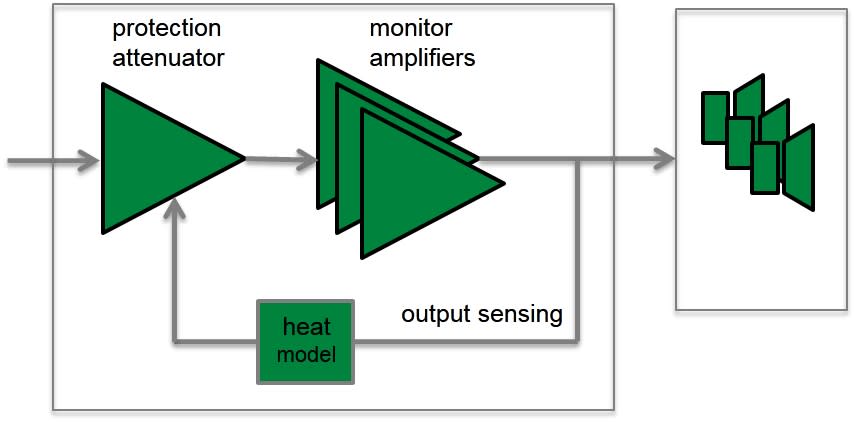
Protection circuitry features and benefits:
- Reduces the output level when required, (e.g. when driver voice coil temperature reaches the safe limit), which highly improves system reliability.
- Appropriate protection circuitry design in every loudspeaker and subwoofer enables the maximisation of system output sound level.
Intelligent Signal Sensing (ISS™) for power consumption reduction in stand-by mode.

Introduced early 2013, Genelec’s Intelligent Signal-Sensing technology has been developed to meet with both European Union ErP Directives and Genelec's own ambitious sustainability standards.
The Intelligent Signal Sensing, ISS™ circuitry tracks the signal input of the loudspeaker and detects if it is in use. If the ISS circuit does not find any audio on the input for a period of time, it sets the loudspeaker to a low-power sleep state and the loudspeaker will consume less than 0.5 watts. When an input signal is detected, the loudspeaker immediately turns itself on.
Additionally an ‘ISS Disable’ switch is located on each product’s back plate next to the other room response controls. First, when the mains power switch of the loudspeaker is set to 'ON', the ISS™ auto-start function (low-power sleep state on/off) of the loudspeaker is active.
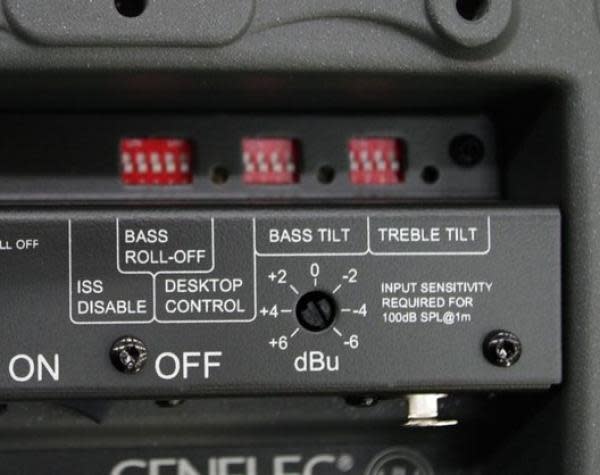
If this function is not desired, the ISS™ function can be disabled by setting the 'ISS Disable' switch on the back panel to 'ON' position. In this mode, the monitor is only powered on and off using the mains power switch.
Note that the mains power switch will always turn the monitor off completely.
Active crossover operating at low signal levels.

Audio electronic crossovers allow the audio signal to be split into separate frequency bands that are separately routed to individual power amplifiers, which are then connected to specific transducers optimised for a particular frequency band.
Active crossovers come in both digital and analogue varieties. Genelec digital active crossovers include additional signal processing, such as driver protection, delay, and equalisation.
Genelec analogue active crossover filters contain electronic components that are operated at low signal levels suitable for power amplifier inputs. This is in contrast to passive crossovers that operate at the high signal levels of the power amplifier's outputs, having to handle high currents and, in some cases, high voltages.
In a typical two-way system the active crossover needs two power amplifiers — one for the woofer and one for the tweeter.
The active crossover design offers multiple benefits:
- The frequency response becomes independent of any dynamic changes in the driver's electrical characteristics or the drive level.
- There is increased flexibility and precision for adjusting and fine-tuning each output frequency response for the specific drivers used.
- Each driver has its own signal processing and power amplifier. This isolates each driver from the drive signals handled by the other drivers, reducing inter-modulation distortion and overdriving problems.
- The ability to compensate for sensitivity variations between drivers.
- The possibility to compensate for frequency and phase response anomalies associated with a driver’s characteristics within the intended pass-band.
- The flat frequency response of a high-quality active loudspeaker is a result of the combined effect of the crossover filter response, power amplifier responses and driver responses in a loudspeaker enclosure.
Using the active approach enables frequency response adjustments and optimisation of the full loudspeaker system, placed in various room environments, without expensive external equalisers. The end result is a simpler, more reliable, efficient, consistent and precise active loudspeaker system.
Laminar Integrated Port (LIP™) allows for precise bass reproduction.

Genelec’s choice for vented (or bass reflex) enclosures dates back to 1978 and the first active monitor developed by Genelec, the S30. Research to improve the performance and efficiency of reflex ports has been pursued ever since.
A typical reflex port enclosure features a tube and an opening area. To avoid turbulences in the tube the air flow should not meet any acute angles as this would generate noise, compression, distortion and losses of the total radiated energy. To minimize the air flow speed, both the tube and its cross section have to be large. Often, the outer enclosure dimensions become a limitation, because a long tube will not fit in the available volume anymore.
The M Series features two vent tubes having opening stretching across half of the enclosure depth to address these specific issues. The novel patent-pending Laminar Integral Port, LIP™, has been flow-optimized using computer-based finite element models to achieve low distortion and high efficiency even at very high audio output levels.
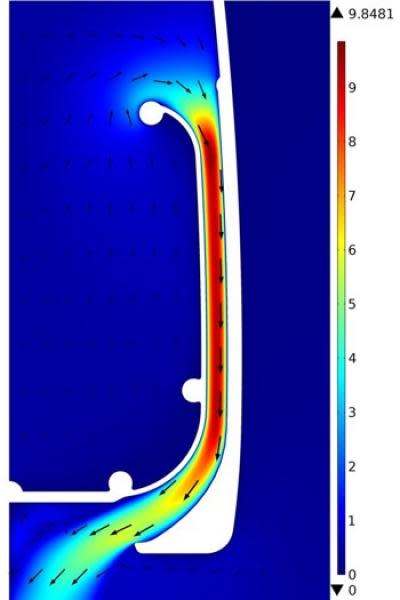
The reflex ports are integrated in the NCE enclosure during the moulding process, avoiding the need for separate additional components. The cross-section plot (Figure) demonstrates the efficient flow characteristics of the port. The natural installation orientation of the M Series is vertical and to allow easy placement of the monitor against a wall, the M Series ports opening face downwards, in the space under the monitor.
The novel Laminar Integrated Port, LIP™, bass reflex system provides accurate low frequency response and faithful tonal reproduction characteristics.
Advanced reflex port design for extended low frequency response.

Genelec’s choice for vented, or reflex, enclosures dates back to the S30 model, the first Genelec product from 1978. Port performance has been improved and refined over the years with the aim to increase the woofer’s low frequency extension and sound pressure level capability to provide outstanding bass articulation and definition.
Both driver and vent contribute to the total radiation of a reflex enclosure. Most radiation comes from the driver, but at the vent-enclosure resonant frequency the driver displacement amplitude is small and most of the radiation comes out of the vent.
To minimise the air speed in the tube, the cross sectional area of the vent should be large. This in turn means that the vent tube has to be long which presents quite a design challenge.
The long, curved tube maximises airflow so deep bass can be reproduced without compression. The reflex tube terminates with a wide flare located on the rear of the enclosure, minimising port noises and providing excellent bass articulation.
The curvature of the tube has also been carefully designed to minimise any audible noise, compression or distortion. The inner end of the tube has proper resistive termination to minimise once again audible chuffing noise and air turbulence.
Proper reflex port design allows also to significantly reduce the woofer’s displacement, improving the linear low frequency output capacity.
Precise room response compensation for optimizing in-room performance.

The interaction between room acoustic and loudspeaker radiation is complex. Each room changes somewhat the monitor’s response in a unique way, e.g. reflective vs. damped rooms, or placement against a wall vs. on a stand away from the walls.
All Genelec loudspeaker systems feature room response adjustments to compensate for the room influences and retrieve a flat frequency response at the listening position.
Analogue Systems
Genelec analogue loudspeaker systems provide versatile Room Response Controls. They include (depending on models):
- Bass Roll-Off and Bass Tilt
- Treble Tilt and Treble Roll-Off
- Bass Level
- Midrange Level
- Treble Level
- Desktop Control

At low frequencies two main controls are provided. The Bass Tilt control, which acts as a shelving filter together with the Bass Roll-off control allowing you to optimize the low and very low frequency response of the system in different installations. Bass, midrange and treble level controls are provided in large systems. These controls allow to optimize the relative balance between the various pass bands.
The operating manual and datasheet of each loudspeaker contains a list of preferred room response control settings for different installations. These have been specified out of long practical experience and measurements of various kind of typical acoustic environments.
Smart Active Monitor (SAM™) Systems
Genelec SAM Systems offer a comprehensive, solution-oriented, intelligently networked product range which all feature Genelec Loudspeaker Manager (GLM™) software and its automatic calibration system called AutoCal™.
Genelec AutoCal provides the industry’s first integrated process for complete automated measurement, analysis, and adjustment of every monitor on the GLM control network. The system measures the response in the listening area and applies relevant compensation in the low and low-mid frequencies to minimise the detrimental room acoustic anomalies as well as the differences between various listening positions. AutoCal also aligns relative levels, time-of-flight, as well as adjusts correct crossover phase (called AutoPhase) for all subwoofers on the network.

The Acoustic Response Editor provides accurate graphical display of the measured response, filter compensation and the resulting system response for each monitor, with full manual control of acoustic settings.
References
Genelec UNIO Explained | How the ecosystem offers seamless in-room and personal headphone monitoring
Genelec Visits Morten Lindberg’s Stunning Immersive Audio Studio
The Ones. Point Source Excellence.
Designing the new W371 Adaptive Woofer System.
Genelec UNIO Explained | How the ecosystem offers seamless in-room and personal headphone monitoring
A quick guide to our UNIO Ecosystem – which offers audio engineers seamless bridging of in-room and personal headphone monitoring. https://genelec.com/UNIO
The Genelec UNIO Ecosystem – which combines the power of our renowned GLM, SAM Monitoring and Aural ID adaptive technologies – gives audio engineers the flexibility to work anywhere, anytime, from stereo to immersive. And now, with the new UNIO Personal Reference Monitoring (PRM) solution, audio professionals benefit from the pinpoint accuracy of our pioneering active monitoring headphone solution, which combines the 9320A SAM Reference Controller with uniquely factory-calibrated 8550A Professional Reference Headphones.
To learn more, visit https://genelec.com/UNIO
Genelec Visits Morten Lindberg’s Stunning Immersive Audio Studio
In the world of immersive music recording, no-one has done more than Grammy-winning sound engineer and music producer Morten Lindberg to set the gold standard for what can be achieved in this field.
We visited Morten at his incredible studio in Oslo, Norway to talk about his approach to immersive recording, and how his new 7.1.4 Genelec monitoring system has become an essential part of his workflow.
Welcome to a fascinating insight into the world of a true immersive audio pioneer.
Documentation
FAQ
W371 does not need a subwoofer because the W371 is itself a very capable low frequency source, in many ways superior to using a subwoofer. In certain immersive installations, a subwoofer can be used as the output method for the LFE channel content. In that case, the subwoofer is calibrated using the GLM as a second step after the primary system calibration.
Bass management means dividing low frequencies into a subwoofer and high frequencies to a loudspeaker, with the typical crossover frequency being in the range 50-100 Hz. A loudspeaker system using W371 with a monitor is a full range system that should not be bass managed. The output quality of the W371 with a monitor is acoustically superior to using a subwoofer and bass management for low frequencies. Because of this, W371 cannot be bass managed with a subwoofer.










